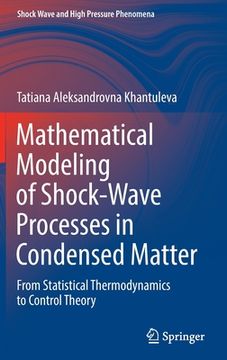Share
Mathematical Modeling of Shock-Wave Processes in Condensed Matter: From Statistical Thermodynamics to Control Theory (in English)
Tatiana Aleksandrovna Khantuleva
(Author)
·
Springer
· Hardcover
Mathematical Modeling of Shock-Wave Processes in Condensed Matter: From Statistical Thermodynamics to Control Theory (in English) - Khantuleva, Tatiana Aleksandrovna
$ 151.57
$ 159.99
You save: $ 8.42
Choose the list to add your product or create one New List
✓ Product added successfully to the Wishlist.
Go to My WishlistsIt will be shipped from our warehouse between
Tuesday, June 04 and
Wednesday, June 05.
You will receive it anywhere in United States between 1 and 3 business days after shipment.
Synopsis "Mathematical Modeling of Shock-Wave Processes in Condensed Matter: From Statistical Thermodynamics to Control Theory (in English)"
Chapter 1 Models of continuum mechanics and their deficiencies 1.1 Description of macroscopic systems; macroscopic variables 1.2 Macroscopic transport equations 1.3 The problem of closure of the transport equations 1.4 Validity of continuum mechanics 1.5 Scale averaging effect on transport processes 1.6 Medium models and transient processes 1.7 The problem of a uniform description of the media motions 1.8 Deficiencies of the continuum mechanics concept 1.9 Short review of approaches to extension of continuum mechanics Chapter 2 Specific Features of Processes Far from Equilibrium 2.1 Experimental difficulties in studying non-equilibrium processes 2.2 Anomalous medium response to strong impact 2.3 The internal structure effects 2.4 Fluctuations, oscillations, instabilities 2.5 Multi-scale energy exchange between various degrees of freedom 2.6 Multi-stage relaxation processes 2.7 Finite speed of disturbances propagation and the delay effects 2.8 Influence of the loading duration and inertial effects 2.9 Dynamic self-organization of new internal structure in open systems 2.10 Predictive ability of modeling non-equilibrium processes Chapter 3 Macroscopic Description in Terms of Non-equilibrium Statistical Mechanics 3.1 Fundamentals of statistical mechanics 3.2 Description of macroscopic systems from the first principles 3.3 Main problem of non-equilibrium statistical mechanics 3.4 Rigorous statistical approaches to non-equilibrium processes 3.5 Non-equilibrium statistical operator by Zubarev 3.6 Bogolyubov's hypothesis of attenuation of spatiotemporal correlations 3.7 The nonlocal thermodynamic relationships with memory between the conjugate macroscopic fluxes and gradients 3.8 Two type of the nonlocal effects 3.9 The disadvantages and new opportunities to close transport equations for high-rate processes Chapter 4 Thermodynamic Concepts Out of Equilibrium 4.1 Basic concepts and principles of thermodynamics 4.2 Linear thermodynamics of irreversible processes 4.3 Revision of the generally accepted thermodynamic concepts out of equilibrium 4.4 Local entropy production near and far from equilibrium 4.5 Total entropy generation and the second law of thermodynamics 4.6 Maximum entropy principle by Jaynes 4.7 Thermodynamic temporal evolution out of equilibrium 4.8 Influence of the constraints imposed on the system 4.9 Self-organization of new structures in thermodynamics Chapter 5 New Approach to Modeling Non-equilibrium Processes 5.1 Generalized constitutive relationships based on non-equilibrium statistical mechanics 5.2 Modeling spatiotemporal correlation functions 5.3 Temporal stages of the correlation attenuation 5.4 Deficiencies of the generally accepted models for the medium with complicated properties 5.5 Requirements to new approach to modeling shock-induced processes 5.6 Foundations of new approach to modeling transport processes far from equilibrium 5.7 New approach to modeling transport processes far from equilibrium 5.8 Distinctive features of new approach from semi-empirical models 5.9 Interrelationships between spatiotemporal correlations and dynamic structure of the system 5.10 Modeling correlation functions in boundary-value problems 5.11 Boundary conditions for nonlocal equations 5.12 The mathematical basis for the self-consistent problem formulation 5.13 Discrete size spectrum of the dynamic structure of a bounded system Chapter 6 Description of the Structure Evolution Using Methods of Control Theory of Adaptive Systems 6.1 Methods of control theory in physics. Cybernetical physics 6.2 Speed gradient principle by Fradkov for non-stationary complex systems 6.3 Description of the system temporal evolution at macroscale level 6.4 Temporal evolution of statistical distribu
- 0% (0)
- 0% (0)
- 0% (0)
- 0% (0)
- 0% (0)
All books in our catalog are Original.
The book is written in English.
The binding of this edition is Hardcover.
✓ Producto agregado correctamente al carro, Ir a Pagar.

